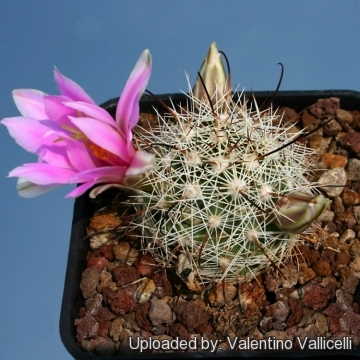Accepted Scientific Name: Mammillaria insularis H.E.Gates ex Shurly
Cact. Succ. J. (Los Angeles) 10: 25. 1938

Ebnerella insularis (Mammillaria insularis) Photo by: Alexander Arzberger
Origin and Habitat: Mexico, Baja California peninsula, endemic of islands (Isla Angel de la Guarda, Isla de San Marcos, Isla Piojo, Isla Smith, Isla Ventana) and area around Bahia de Los Angeles
Synonyms:
Description: Sometimes solitary this species may forms groups, but it grows very slowly and it can take much time until a stem branches for the first time.
Stem: Soft, globose to depressed conical when growing in habitat. While cultivated plant have (frequently) oblong offsetting , green or grey-green epidermis that tinge, Up to 6(-9) cm tall, 5(-9) in diameter
Flowers: Showy, nearly as large as the plant bodies up to 3 cm long (or more), from almost full white to pink with white edges to completely pink, .
Blooming season: Midsummer
Notes: Mammillaria insularisSN|5431]]SN|5431]] was once placed in the segregate genus Bartschella because of its fruit anatomy and large pink flowers located at the top of the plant. The fruit are red, thin-skinned and often break off from a basal pore rather than falling whole (like in most Mammillaria).
 - The flowers are very showy and nearly as large as the plant bodies. (Mammillaria insularis) Photo by: Valentino Vallicelli
- The flowers are very showy and nearly as large as the plant bodies. (Mammillaria insularis) Photo by: Valentino VallicelliSend a photo of this plant.The gallery now contains thousands of pictures, however it is possible to do even more. We are, of course, seeking photos of species not yet shown in the gallery but not only that, we are also looking for better pictures than those already present.
Read More... Cultivation and Propagation: This plant is somewhat difficult to cultivate. During the summer it is best to keep the plants outside where the temperature can rise to over 30 C with no harm to the plant. Furnish good drainage and use a an open and free draining mineral compost that allows therefore roots to breath (as it is rot prone) It likes a winter's rest and should be kept almost completely dry during the winter months, If the soil is allowed to be dry for too long root loss could follow but equally the same result would occur if the plants are both wet and cold. From March onwards the plant will begin to grow and watering should be increased gradually until late May when the plant should be in full growth. Water regularly during the summer so long as the plant pot is allowed to drain and not sit in a tray of water. During hot weather you may need to water the plants more frequently so long as the plant is actively growing. From late September watering should be reduced to force the plant to go in to a state of semi dormancy, by October you should be back in to the winter watering regime.
Need full sun avoiding only the harshest summer sun, if kept too dark they may become overly lush and greener and could be prone to rotting due to over watering.
Feeding may not be necessary at all if the compost is fresh then, feed in summer only if the plant hasn't been repotted recently. Do not feed the plants from September onwards as this can cause lush growth which can be fatal during the darker cold months. Grown specimens resist to -4°C for a short time, but it is best to keep above 5° C to avoid ugly spots on the plant epidermis.
Propagation: *Direct sow after last frost. (seldom produces offsets)












